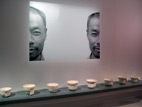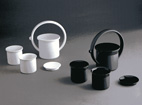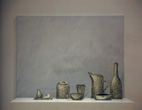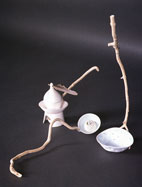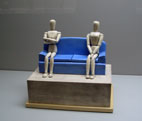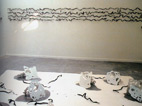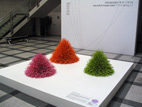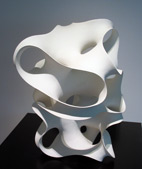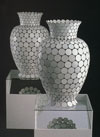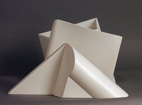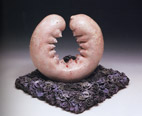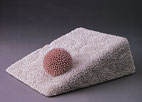

Zen Parry
[Editor's Note: This is the second of a series of letters from artist Zen Parry describing her experience of the 2005 Third World Ceramic Biennale in the Republic of South Korea.]
Hello Forrest,
You probably want to hear more about ceramics, now, and not just my naiveté with this experience?! I know that you were a juror for an exhibition this summer, but I hadn't fully considered the implications of participating in the organization of such an event—let alone the Ceramic Biennale.
Taking directly from the opening essay in the catalogue written by Ms. Judith Schwartz, Chair of the Jury Committee, I learned that over three screening days, they viewed 2,475 entries! Just thinking about viewing slides for three days is eye opening (or eye closing) realization. How many slide trays is that? How many slide jams?!? How many entries unreadable? Thinking about it gave me a new appreciation for digital images and cd-rom's. From the juring process, 190 works were selected representing thirty-two countries with artists ranging in age from twenty-two to seventy-seven.
Ms. Schwartz continues, "There were marvelously expressive bowls, dishes, cups, vases, lamps and teapots, with forms that nested, stacked, spread or teeter-tottered. These were sculptures representative of Pop, Surrealism, Illusionism, Trompe L'oeil, Minimalism, Abstract Expressionism, Conceptualism, and Installation. There was widespread use of the photographic image, new manipulations of digital technology for surface decoration, and large-scale off-the-pedestal onto-the-floor placements."
Having seen the exhibition a number of times, this articulation really does set the stage for something that is difficult to describe—seeing the works exhibited, pondering and contemplating each piece, or even just walking through quickly, one can't help but be arrested by certain pieces—the work is just so surprising.
Judith Schwartz explains, "Entries were evaluated based on their artistic content, technical sophistication, and originality. We discovered how difficult it was to decipher the national origin of a given work as the identity of the artists and their nationalities were not revealed until the very end of the process. Besides the obvious traditional techniques specific to certain countries, it was impossible to determine borders. Globalization had clearly penetrated the ceramic world."
Having never met Ms. Schwartz previously, it was quite wonderful to hear her voice and put her warm tone with those written comments. Walking around the exhibition only confirmed her comments—you couldn't tell where the works originated from unless you read the labels. The range of works selected were nothing short of astounding. And this is only one exhibition—there are another eight of equally high caliber!
The Biennale competition was divided into two categories: Ceramics for Use, a section comprised of functional work, and Ceramics for Expression, a section containing non-functional work. Some of the work in Ceramics for Expression was functional, which, as Ms. Schwartz articulated, "this trend illuminates and probably responds to the prejudice of the larger art community whose invidious misconceptions about ceramics for use have seemingly relegated the category to a lesser standing. However, perhaps it was the artist themselves, working with the functional form, who labeled their work 'expressive' to reclaim attention to the artistic content that has always been present in these functional objects. Accordingly, the vessel section was never more vibrant than this year."
This was the first time in the history of the competition that the Grand Prize was awarded to a vessel maker, Philippe Barde of Switzerland. His presentation was also knock-out. The most striking attribute about Philippe's work was that he took a simple concept— the vessel—and altered one attribute—symmetry (or our perceptions of such). Through his meticulous reassembly of two differing halves, he simultaneously returned the vessel to functionality, made a statement about wholeness and beauty and in the process created a metaphor.
The award winners:
Ceramics for Use
- Gold Prizes
- Masanobu Ido, Japan (This work blew me away—the spout is in the circular handle that sits like a halo over the vessel part of the teapot. The first time you look at it, you can't figure it out—"why is this so cool?" and then it hits you. So subtle and so smart at the same time.)
- Irene Kwai Ying Lau, China (The work is quite deceptive because of her use of pencil marks and shading to create a distorted perspective on three dimensional objects. At first glance, you think you are looking at a hand drawn, amateurishly shaded still life.)
- Silver Prizes
- Antje Reinhardt, Germany (A mobile tea set that comes in its own collapsible elegant box, which then becomes a serving base.)
- Insook Rhee and Jeeyon Yum, Korea (A dinner set that stacked together like a puzzle. One couldn't tell it was a dinner setting until it was disassembled; until then, assembled, it sat in a corner.)
- Bronze Prizes
- Huiyin Shih, Taiwan
- Rupert Spira, UK
- Simon Ward, UK (Beautifully quirky, perfectly functional utensils, that incorporated natural wooden elements, metal work and a good dose of wry humour.)
- Special Prizes
- Jaehoon Choi, Korea (Dry press clay assembled with hollow midsections and blue LED lights were inserted. They looked like glowing bricks.)
- Sangwook Huh, Korea (This was one of a few pieces in the exhibition that I could identify the nationality of the creator, based on traditional craft practices.)
- Kirstine Kejser Jenbo, Denmark (Clean, elegant white lines with natural wood. Very nice and very Danish.)
- Shingo Takeuchi, Japan (So pseudo-Jun-Kaneko-Dango)
Ceramics for Expression
- Silver Prizes (there was no Gold prize category)
- David Furman, USA (The quiet figures spoke volumes.)
- Yasuko Hasegawa, Japan (His slab built porcelain piece was called Barrier. I couldn't tell if it was the perception of fragility that was the barrier or the structures he built as metaphor. They were beautiful in their simplicity.)
- Bronze Prizes
- Leonne Hendriksen, The Netherlands
- Kenjiro Kitade, Japan
- Yuna Park, Korea
- Special Prize
- William Catling, USA (A striking, rangey figure that seemed quite haunting.)
- Bean Finneran, USA (Installed in the foyer of the Museum, taking full advantage of the natural light and the surfaces of her hand rolled curves.)
- Eva Hild, Sweden (Her classic form held an audience as they actively asked themselves, "how is it made?")
- Yauhio Watarai, Japan (Large vase forms made of medallions soldered together and placed on a mirror to that one could view underneath.)
- Jurors Choice
- Marica Fuster, Switzerland
- Jungwon Lee, Korea (Her Internal Human Body was so inviting to touch and then so repulsive!)
- Yauheni Adzinochanka, Belarus (White Wedge seemed reminiscent of a sponge and sea urchin.)
- Jungsuk Lee, Korea (A series of 7 raku masks mounted on tall pipes.)
- Shuji Yoshikawa, Japan (Monochromatic black pieces that interlocked.)
That is it for now. I hope you enjoyed seeing a little bit of what I experienced. Next time, I'll be attending the symposium "Reframing Ceramics". Given what I have seen, I am starting to think that ceramics has already been reframed!
Ciao,
Zen
Links
Zen Parry
http://www.ovoo.com
The World Ceramic Biennale
http://www.wocef.com
http://www.worldceramic.or.kr
